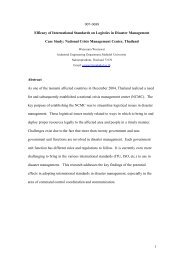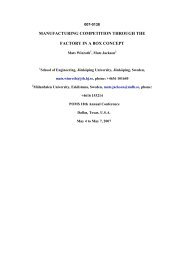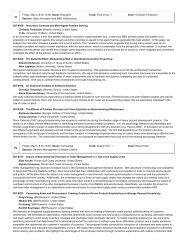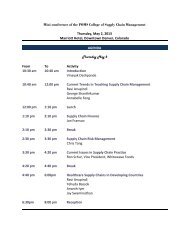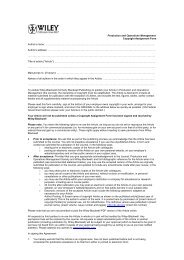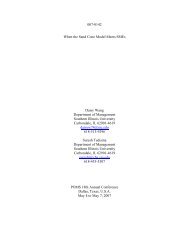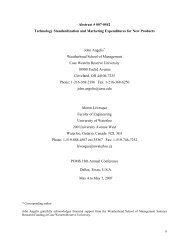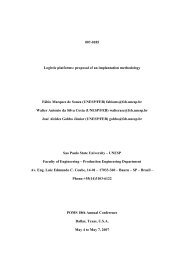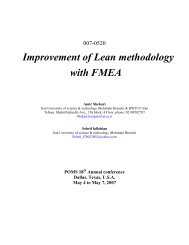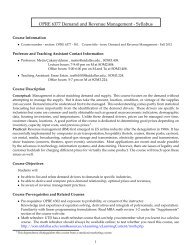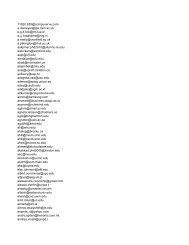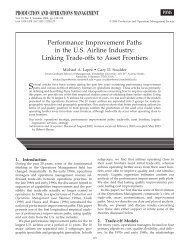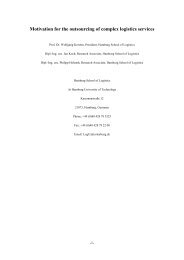Year Q u a n tity - (POMS) is
Year Q u a n tity - (POMS) is
Year Q u a n tity - (POMS) is
Create successful ePaper yourself
Turn your PDF publications into a flip-book with our unique Google optimized e-Paper software.
Abstract Title: Automotive remanufacturing: The challenges<br />
European remanufacturers are facing<br />
Abstract Number 007-0271<br />
Author Contact Details:<br />
Margarete A. Seitz<br />
Consultant<br />
Capgemini Deutschland GmbH<br />
Supply Chain Management<br />
Löffelstraße 44-46<br />
70597 Stuttgart<br />
Germany<br />
T: +49 (0) 711 50505 865<br />
F: +49 (0) 711 50505 333<br />
E-Mail: margarete.seitz@capgemini.com<br />
<strong>POMS</strong> 18th Annual Conference Dallas, Texas, U.S.A. May 4 to May 7, 2007
Automotive remanufacturing: The challenges European remanufacturers are<br />
facing<br />
Seitz, M.A 1<br />
1 Capgemini Deutschland GmbH – Consulting. Technology. Outsourcing. Löffelstraße<br />
44-46, 70597 Stuttgart, Germany. Margarete.Seitz@capgemini.com<br />
Abstract<br />
Remanufacturing has been branded as the process of transforming used, worn out or<br />
broken parts, components or products into an ‘as good as new’ condition. However,<br />
for decades, remanufacturing has been undertaken by generally small and independent<br />
automotive remanufacturers in Europe. Th<strong>is</strong> research shows that larger, European<br />
remanufacturers have struggled to set up large-scale and automated remanufacturing<br />
operations. As a matter of fact, there are only a handful of large automotive<br />
remanufacturers in Europe, trying to replicate mainstream manufacturing processes<br />
within their recovery plants.<br />
Th<strong>is</strong> article outlines the major <strong>is</strong>sues and obstacles European remanufacturers are<br />
facing, hereby focusing on large-scale, OEM remanufacturers. The research<br />
demonstrates that high product variation and high scrap rates contribute to parts<br />
management <strong>is</strong>sues. Further obstacles ar<strong>is</strong>e in the form of return forecasting and<br />
engine pricing. Th<strong>is</strong> article explains the causes of these <strong>is</strong>sues, their effects and how<br />
they might be overcome.<br />
Keywords:<br />
Automotive sector, remanufacturing, Original Equipment Manufacturer (OEM)<br />
2
Introduction<br />
Over the past decade, the increasing interest in product return, recovery and the<br />
d<strong>is</strong>tribution of recovered products has led to a number of contributions in the areas of<br />
reverse log<strong>is</strong>tics, product recovery and closed-loop supply chain management. While the<br />
earliest contributions (e.g. Pohlen and Farr<strong>is</strong>, 1992, and Stock, 1992) have focused on<br />
reverse log<strong>is</strong>tics, the field has developed into the investigation of the whole supply chain<br />
for recovered goods, the closed-loop supply chain (e.g. Seitz and Peattie, 2004).<br />
There are various product recovery operations in the automotive sector, including<br />
recycling, reconditioning and remanufacturing. Th<strong>is</strong> article investigates remanufacturing<br />
only, which <strong>is</strong> defined as the transformation of an end-of-life product into a product<br />
with an ‘as good as new’ condition.<br />
Th<strong>is</strong> article outlines the major <strong>is</strong>sues and obstacles European remanufacturers are<br />
facing. The research demonstrates that high product variation and high scrap rates<br />
contribute to parts management <strong>is</strong>sues. Further obstacles ar<strong>is</strong>e in the form of return<br />
forecasting and engine pricing. In the following, the author will explain the causes of<br />
these <strong>is</strong>sues, their effects and how they might be overcome.<br />
Methodology<br />
Th<strong>is</strong> article <strong>is</strong> based on a three-year research project on automotive remanufacturing,<br />
taking a case-study approach. More than one hundred and thirty interviews were<br />
conducted within the facilities of vehicle manufacturers and remanufacturers.<br />
3
Interviews were semi-structured and structured. Interviewees came from all functional<br />
levels, including executives (centre manager; head of department), middle management<br />
(planners; admin<strong>is</strong>trators) and workers (assembly-line staff; warehouse operators).<br />
Interview data was supplemented with (process) observation, business process mapping<br />
and secondary data gathering.<br />
The European Remanufacturing Market<br />
There are three main types of players in the European automotive remanufacturing<br />
market. These will be outlined in the following.<br />
OEM Remanufacturers<br />
According to Lund (1984), OEM remanufacturers are original equipment<br />
manufacturers, whose focus <strong>is</strong> on the production of new parts and for whom<br />
remanufacturing <strong>is</strong> an added business. Applied to th<strong>is</strong> research, OEM remanufacturers<br />
are the vehicle manufacturers. With regard to the size of the businesses, OEM<br />
remanufacturers tend to be larger in terms of sales and employment (Sherwood and Shu,<br />
2000; Schwarck, 2003a).<br />
Sherwood and Shu (2000) have observed that OEM engine remanufacturing working<br />
practices differ from remanufacturing procedures undertaken by independents.<br />
According to Sherwood and Shu (2000), independents’ priority <strong>is</strong> the saving of a<br />
particular part, whereas OEMs tend to scrap parts that are uneconomical to repair or<br />
would take longer than average to remanufacture. In fact, independent engine<br />
remanufacturers have developed special repair methods in order to util<strong>is</strong>e as many parts<br />
from a used product (the ‘core’) as possible. Th<strong>is</strong> observation has been confirmed by<br />
4
Szuhy, who claims that, within the independent sector, “[…] only with great reluctance<br />
are pieces ever thrown out” (in Waters, 1984, no page given).<br />
Guide (2000) claims that in the United States, original equipment manufacturers remain<br />
largely d<strong>is</strong>engaged and account for only 5% of the total industry. In the European<br />
automotive sector however, car manufacturers possess a larger market share than US<br />
remanufacturers (Schwartz, 1995). Th<strong>is</strong> relatively higher share of OEM remanufacturers<br />
in Europe may be a result of the increase in European take-back laws, in which OEMs<br />
are responsible for product take-back, recovery and covering all the costs (Fle<strong>is</strong>chmann<br />
et al., 2000). “In the USA, OEMs are often not formally responsible and product<br />
recovery <strong>is</strong> driven by private, commercial initiatives” (Fle<strong>is</strong>chmann et al., 2000, p.661).<br />
Independent Remanufacturers<br />
Lund (1984) defines independent remanufacturers as those businesses, which focus on<br />
the remanufacturing of products produced by others. According to Schwartz (1995)<br />
these remanufacturers do not have any connection to the vehicle or the original<br />
manufacturer. Lund (1984) claims that the typical independent remanufacturer <strong>is</strong> a<br />
private, small corporation, “[…] usually operating on a hand to mouth bas<strong>is</strong> competing<br />
in a complex and uncertain environment” (Ferrer and Whybark, 2001, p.113).<br />
Independent remanufacturers not only need to acquire design information from the<br />
OEMs, but also depend on new parts to be included in the remanufacturing operation. In<br />
some cases, these parts are only available from the original manufacturer or the supplier.<br />
Th<strong>is</strong> <strong>is</strong> particularly true for parts in over- or undersizes, such as bearing shells. Th<strong>is</strong><br />
dependency can be critical with regard to delivery times and prices. Hence, some<br />
independent players manufacture their own new parts. They frequently incorporate<br />
5
modifications of the original design or upgrade ex<strong>is</strong>ting technology (Waters, 1984).<br />
Moreover, a whole business sector has developed around remanufacturers, providing<br />
them with new parts such as cylinder liners, new p<strong>is</strong>tons or bearing shells, since vehicle<br />
manufacturers have tried to exclude their independent competitors from access to (new)<br />
replacement parts (Waters, 1984). In the United States, these practices by OEMs have<br />
been declared as ‘unfair trade practices’ and have since ceased (Waters, 1984).<br />
However, as th<strong>is</strong> research will show, new parts procurement has also proven to be a<br />
challenge for OEM remanufacturers, who often compete for parts with the ‘new<br />
assembly line’.<br />
Subcontracted Remanufacturers<br />
Within th<strong>is</strong> research, a subcontracted remanufacturer <strong>is</strong> defined as a business<br />
contractually bound to an original equipment manufacturer. Th<strong>is</strong> may be a business<br />
which provides services to a vehicle manufacturer or an original equipment parts<br />
manufacturer. Generally, subcontracted remanufacturers provide services for an OEM<br />
while remanufacturing for their own purposes as independent players. A major<br />
advantage of subcontracted remanufacturers <strong>is</strong> the access to specification sheets and<br />
design information which <strong>is</strong> provided by the OEM, so that quality levels and product<br />
specifications can be met. “In some cases, the independent remanufacturer may be<br />
operating under a franch<strong>is</strong>e from a major OEM such as Ford or General Motor’s Detroit<br />
Diesel/All<strong>is</strong>on Div<strong>is</strong>ion, in which case technical ass<strong>is</strong>tance and parts are available from<br />
the OEM” (Lund, 1984, p.12).<br />
However, not just technical specification sheets but also equipment and machinery <strong>is</strong><br />
provided by the OEM. Mostly, th<strong>is</strong> machinery compr<strong>is</strong>es the equipment of the<br />
6
production line on which the products were originally made. In addition, the OEM may<br />
also take care of the core collection, too. Moreover, a subcontracted remanufacturer may<br />
provide further services such as the machining of engine parts, low volume assembly,<br />
warranty investigation or dynamometer testing (Autocraft Industries UK, 2003).<br />
A Typical Engine Remanufacturing Process<br />
Every remanufacturing process cons<strong>is</strong>ts of several phases. Th<strong>is</strong> section briefly outlines<br />
the specific engine remanufacturing process as it was observed within the case<br />
companies. While the manufacturing process of new engines <strong>is</strong> a highly automated<br />
process (e.g. the machining of parts) and character<strong>is</strong>ed by high volume outputs, engine<br />
remanufacturing <strong>is</strong> largely manual throughout the process.<br />
Figure 1 shows the process steps, typically involved within engine remanufacturing.<br />
First of all, engines are moved from the core warehouse to the d<strong>is</strong>assembly and cleaning<br />
process, in which they are completely d<strong>is</strong>assembled. In the next step parts are manually<br />
identified and sorted. Very rusty or greasy parts are chemically cleaned before they can<br />
be thoroughly inspected. After having been cleaned, parts undergo a quality check. Only<br />
parts of good quality will be recovered during the next step, all other parts will be<br />
recycled. Certain parts will be recovered by external remanufacturers. However, after<br />
recovery all parts are stored in the parts warehouse, where new parts are stored.<br />
According to assembly schedules they are put together to form a remanufactured engine.<br />
The cold and/or hot test completes the remanufacturing process. Hereby, engines<br />
undergo either a leak test (with liquids) or are started and run for a certain time (hot<br />
test).<br />
7
Core<br />
Warehouse<br />
D<strong>is</strong>assembly<br />
and Cleaning<br />
• 50 engines per day<br />
• Complicated by grease, dirt, rust<br />
• High throughput times<br />
Identification<br />
and Control<br />
• Manual inspection<br />
• Time-consuming<br />
Chemical<br />
Cleaning<br />
• Deeper chemical cleaning<br />
process for very oily or rusty parts<br />
• Cylinder head and oil filter<br />
Quality Control<br />
Parts<br />
Recovery<br />
• Recovery includes boring,<br />
machining, grinding and honing<br />
• Single workstations<br />
• Highly manual work<br />
• Weighing and gauging to ensure<br />
that parts meet specifications<br />
• Stock amounted to 13,000 engines, which equals the average<br />
remanufacturing output of one year<br />
• Core inflow <strong>is</strong> larger than outflow due to new parts added to the process<br />
• Stock value: €32.5 million<br />
Material<br />
Recycling<br />
Legend:<br />
Cores / used parts<br />
Remanuf. parts<br />
Scrap / recycling<br />
Scrap if…<br />
• Part heavily damaged<br />
• No demand (check in PPS system); excess stock<br />
• Recovery technically not feasible<br />
• Part has been replaced by improved version<br />
• P<strong>is</strong>ton and p<strong>is</strong>ton pins always d<strong>is</strong>carded<br />
Packaging and<br />
Shipment<br />
Figure 1: Typical Engine Remanufacturing Process<br />
(Source: adapted from Seitz and Peattie, 2004, p.79)<br />
External<br />
Remanufacturing<br />
Parts<br />
Warehouse<br />
• Stores used, remanufactured & new parts<br />
• 31 million parts<br />
• New parts in engines: 27% for diesel;<br />
35% for petrol<br />
Engine Re-<br />
Assembly<br />
• 16 main process cycles<br />
• Small batches<br />
• High product variation<br />
Cold Test/ Hot<br />
Test<br />
Rework<br />
1% to 5%<br />
• Testing for leaks<br />
• Dynam. testing for 20% of<br />
regular runners<br />
• Dynam. testing for all irregular<br />
runners and strangers<br />
8
Main Challenges to European Automotive Remanufacturing<br />
Delivery times for parts<br />
Within the case companies, a typical remanufactured engine cons<strong>is</strong>ts of three types of<br />
parts: parts remanufactured within the same plant, parts that are remanufactured<br />
externally, and completely new parts. At the time of the research, OEM engine<br />
remanufacturing facilities tended to remanufacture just 30% (on average) of the engine<br />
parts within their facilities. Hence, more than two thirds of the engine parts were<br />
obtained externally. Th<strong>is</strong> included completely new parts (such as p<strong>is</strong>tons and bearing<br />
shells that were purchased from suppliers), externally remanufactured parts (from a<br />
remanufacturer outside the company) and internally remanufactured parts<br />
(remanufacturing service within the group/company). These are examples for OEMs<br />
while observations within independents have shown that the smaller the facility and the<br />
more independent a remanufacturer, the more parts the company will remanufacture or<br />
produce within their own facilities.<br />
During the research it was observed that delivery times for externally remanufactured or<br />
new parts, such as turbochargers or nozzle holders, can take up to 12 weeks. As a result<br />
the case companies were forced to keep high inventory levels in order to prepare for<br />
bottlenecks in the supply of certain parts.<br />
Other case companies, particularly the subcontracted (i.e. partly independent<br />
remanufacturers that, for example, undertake services for vehicle manufacturers), found<br />
themselves competing for parts with their client’s current serial engine production. The<br />
difficulty hereby <strong>is</strong> to acquire spare parts in the right quantities and on time, since ‘the<br />
line comes first’. In other words, vehicle manufacturers request that their suppliers give<br />
9
priority to the assembly line for brand-new engines. It therefore seems as if<br />
remanufacturers only come in second place in the ‘order fulfilment hierarchy’.<br />
A third obstacle many remanufacturers are facing <strong>is</strong> them m<strong>is</strong>sing out on price benefits<br />
for high ordering quantities, since remanufacturing plants tend to order small quantities<br />
of new parts for their remanufacturing processes, or even have parts custom-made.<br />
Scrap rates<br />
In academic remanufacturing literature, there has been a d<strong>is</strong>tinction between ‘failure<br />
mode’, the nature of the failure, and ‘scrap mode’, the cause for parts not being<br />
recovered. As a result, within engine remanufacturing, one can find failure modes<br />
including ‘wear’, ‘burn’, ‘bent’, ‘crack’, ‘corrosion’, ‘holes’, ‘fracture’ and ‘handling<br />
damage’. Scrap modes include the over- or undersize of parts or simply overstock (for<br />
further information, see Sherwood and Shu, 2000).<br />
In th<strong>is</strong> research no particular emphas<strong>is</strong> was put on the identification of failure and scrap<br />
modes for certain parts, but on scrap rates in general. Cores do not represent a very<br />
reliable source of ‘raw material’. The timing of return often <strong>is</strong> uncertain and the quality<br />
of returned parts and components can range dramatically. The research found that<br />
generally, OEM remanufacturers, and also large independent remanufacturers, tend to<br />
have higher scrap rates than small independents. During one company v<strong>is</strong>it the owner of<br />
a small engine remanufacturing firm demonstrated how they cut their own seals from<br />
rubber sheets, whereas larger firms bought the seals ready-made. On the other hand,<br />
during v<strong>is</strong>its to OEMs, scrap rates of up to 42% were found for cylinder blocks in one<br />
facility, levels unheard of in small remanufacturing firms. Hence, there <strong>is</strong> an overall<br />
high uncertainty of the quality and re-usability of parts in a core.<br />
10
Product Variation<br />
Th<strong>is</strong> research has found that in larger remanufacturing facilities, and particularly in<br />
OEM remanufacturing facilities with high remanufacturing volumes, managing engine<br />
variety can be a big challenge. Th<strong>is</strong> <strong>is</strong> based on the fact that a specific car model might<br />
be produced for an average of six to ten years. However, within th<strong>is</strong> time, engines are<br />
continuously upgraded due to construction and design errors, or the implementation of<br />
new technologies. External constraints such as governmental regulations (exhaust<br />
norms), further increase the amount of engine variants in each model, or type, of engine.<br />
While small independents often easily deal with engine variety (due to their flexible<br />
approach to remanufacturing), OEMs and very large engine remanufacturers strive to<br />
replicate serial engine production in their remanufacturing facilities (flow production).<br />
As a result, high engine variety has many impacts on batch sizes within the re-assembly<br />
process, and also on inventory management and labour, such as the range of skills for<br />
various engine variants.<br />
There have been assumptions that by creating many variants of the product, original<br />
manufacturers aimed at complicating remanufacturing for ‘outsiders’. But th<strong>is</strong><br />
assumption seems far-fetched, since it <strong>is</strong> mostly the OEMs that seem to struggle with<br />
product variation. Within th<strong>is</strong> research, most independents claimed product variety did<br />
not pose any problems in the remanufacturing process. However, a general <strong>is</strong>sue<br />
resulting from engine variety are overall high inventory levels of engine cores, new<br />
parts as well as fin<strong>is</strong>hed goods.<br />
11
Forecasting of Engine Demand<br />
Forecasting future demand for a product <strong>is</strong> always a challenge, not just in a<br />
remanufacturing environment. However, here it <strong>is</strong> even more difficult, given the fact<br />
that the demand for remanufactured engines <strong>is</strong> generally linked to unpredictable engine<br />
failure. Within the research, none of the case companies used demand forecasting tools.<br />
One interviewee at a large OEM owned engine remanufacturing plant even stated: “we<br />
used to request a forecast from our two major customers. These figures however, never<br />
matched the subsequent orders and we therefore ceased to forecast future demand for<br />
remanufactured engines.”<br />
However, some indications can be gained if looking at specific car engines individually.<br />
Figures 1 to 4 give an indication of how the two product life cycles, new and<br />
remanufactured, relate. Th<strong>is</strong> information may ass<strong>is</strong>t in forecasting future demand, but it<br />
has to be said that life cycles differ very much between engine models. The following<br />
graphs show four examples of engine lifecycles. The new engine lifecycle (serial<br />
production) <strong>is</strong> compared to the remanufacturing lifecycle of the same engine model.<br />
12
Quan<strong>tity</strong><br />
240.000<br />
220.000<br />
200.000<br />
180.000<br />
160.000<br />
140.000<br />
120.000<br />
100.000<br />
80.000<br />
60.000<br />
40.000<br />
20.000<br />
0<br />
1980 1981 1982 1983 1984 1985 1986 1987 1988 1989 1990 1991 1992 1993 1994 1995 1996 1997 1998<br />
<strong>Year</strong><br />
Figure 2: Product life cycles Petrol Model 1<br />
(Source: Seitz, 2006, p.236)<br />
Petrol Model 1 New<br />
Petrol Model 1 Reman
Quan<strong>tity</strong><br />
140.000<br />
130.000<br />
120.000<br />
110.000<br />
100.000<br />
90.000<br />
80.000<br />
70.000<br />
60.000<br />
50.000<br />
40.000<br />
30.000<br />
20.000<br />
10.000<br />
0<br />
1980 1981 1982 1983 1984 1985 1986 1987 1988 1989 1990 1991 1992 1993 1994 1995 1996 1997 1998<br />
<strong>Year</strong><br />
Figure 1: Product life cycles Petrol Model 2<br />
(Source: Seitz, 2006, p.237)<br />
Petrol Model 2 New<br />
Petrol Model 2 Reman
Quan<strong>tity</strong><br />
140.000<br />
130.000<br />
120.000<br />
110.000<br />
100.000<br />
90.000<br />
80.000<br />
70.000<br />
60.000<br />
50.000<br />
40.000<br />
30.000<br />
20.000<br />
10.000<br />
0<br />
1980 1981 1982 1983 1984 1985 1986 1987 1988 1989 1990 1991 1992 1993 1994 1995 1996 1997 1998<br />
<strong>Year</strong><br />
Figure 2: Product life cycles Diesel Model 1<br />
(Source: Seitz, 2006, p.238)<br />
Diesel Model 1 New<br />
Diesel Model 1 Reman
Quan<strong>tity</strong><br />
140.000<br />
130.000<br />
120.000<br />
110.000<br />
100.000<br />
90.000<br />
80.000<br />
70.000<br />
60.000<br />
50.000<br />
40.000<br />
30.000<br />
20.000<br />
10.000<br />
0<br />
1980 1981 1982 1983 1984 1985 1986 1987 1988 1989 1990 1991 1992 1993 1994 1995 1996 1997 1998<br />
<strong>Year</strong><br />
Figure 3: Product life cycles Diesel Model 2<br />
(Source: Seitz, 2006, p.239)<br />
Diesel Model 2 New<br />
Diesel Model 2 Reman
A compar<strong>is</strong>on between all figures in the research database showed that in the past,<br />
and on average, remanufacturing of an engine model begins five years after the<br />
beginning of serial production. However, it was d<strong>is</strong>covered that th<strong>is</strong> time span has<br />
reduced over time. Nowadays, remanufacturing of engines might start as soon as the<br />
first new engines become available on the market.<br />
Summary and Conclusion<br />
Th<strong>is</strong> research has outlined the <strong>is</strong>sues and obstacles European engine remanufacturers<br />
are facing. These include long delivery times for parts, high scrap rates within the<br />
used product (core), as well as high product variation and the <strong>is</strong>sue of forecasting<br />
demand for remanufactured engines. As a result, the research observed high stock<br />
levels, long turnaround times and small batch sizes in a rather rigid remanufacturing<br />
environment. Larger remanufacturers have been trying to replicate high volume<br />
engine manufacturing processes onto their remanufacturing activities, but struggle<br />
with the <strong>is</strong>sues identified in th<strong>is</strong> article.<br />
One way of overcoming these <strong>is</strong>sues might be the application of lean manufacturing<br />
principles onto remanufacturing processes. Th<strong>is</strong> idea has only just gained attention in<br />
recent years. The Lean Remanufacturing Workshop at the ReMaTec in 2003, for<br />
example, aimed at ra<strong>is</strong>ing ‘lean awareness’ among remanufacturers, by introducing<br />
them to the benefits of the application of lean principles (Fargher, 2003a). According<br />
to Fargher (2003b), lean remanufacturing <strong>is</strong> the identification and elimination of non-<br />
value-added activities through continuous improvements within a remanufacturing<br />
environment. He has outlined various benefits of lean remanufacturing, which are<br />
l<strong>is</strong>ted in the following.<br />
17
� Reduction of remanufacturing turn-around-time 1<br />
� Improved on-time shipments<br />
� Reduced work in progress<br />
� Improved quality<br />
� Reduced floor space<br />
After solid research and documentation of the remanufacturing processes of gas<br />
turbine compressors, helicopter rotor blades and hydraulic components (Fargher,<br />
1997), Fargher presented a comprehensive introduction to lean remanufacturing at<br />
ReMaTec 2003 (Fargher, 2003a). He d<strong>is</strong>covered that a clear sense of urgency and<br />
willingness to change are essential elements to ensure the success of applying lean<br />
principles to a remanufacturing environment. Research efforts have also been made<br />
by Amezquita and Bras (1996). However, there <strong>is</strong> the need for more empirical<br />
research in th<strong>is</strong> direction.<br />
Th<strong>is</strong> research has d<strong>is</strong>covered that there are a large number of ‘wastes’ and thus, there<br />
should be an urgency for change within OEM engine remanufacturing. However,<br />
remanufacturers seem to be rather reluctant to changing their working practices. Th<strong>is</strong><br />
phenomenon has been confirmed for the overall engine remanufacturing sector by one<br />
interviewee during the research who argues that engine remanufacturers are loath to<br />
adopting fundamental changes to their current practice:<br />
There are many more variants of each engine now because with electronics it<br />
<strong>is</strong> easier to produce these variants. The problem of the aftermarket <strong>is</strong> to<br />
identify the common features of engine families and hold stock to th<strong>is</strong> level<br />
1 Fargher (1998) defines the turn-around-time as the specific amount of time (in working days) which<br />
<strong>is</strong> required “to progress from induction to acceptance and packaging for storage or shipment to the<br />
customer” (p.x). Th<strong>is</strong> term <strong>is</strong> also called ‘flow time’ or ‘repair lead time’.<br />
18
until the very last minute and fin<strong>is</strong>h it off to order. I have d<strong>is</strong>cussed th<strong>is</strong> with a<br />
number of engine re-manufacturers who see th<strong>is</strong> proposal as a fundamental<br />
change to their current working practices and are loath to adopt it. 2<br />
Future research should therefore closely examine the overall remanufacturing process<br />
of one product, produce a map of the current state and improve the process by the use<br />
of lean tools and techniques (e.g. Bicheno, 2000). Should the results prove that the<br />
processes significantly improve, a suitable production system for remanufacturing<br />
might have been identified. Th<strong>is</strong> <strong>is</strong> particularly necessary, since the application of<br />
mainstream engine manufacturing onto a remanufacturing environment was found as<br />
unsuitable for high-volume remanufacturing processes.<br />
2 Quoted from personal communication (E-Mail) with Edward J. Hadingham, the Managing Director<br />
European Operations of Power Systems Research in Brussels, Belgium, September 2003.<br />
19
Acknowledgements<br />
The author would like to thank Capgemini Deutschland GmbH, and particularly<br />
Michael Schlenker for supporting the d<strong>is</strong>semination of these research results at the<br />
<strong>POMS</strong> 2007 conference.<br />
References<br />
Amezquita, T. and Bras, B. (1996). "Lean Remanufacture of an Automobile Clutch,"<br />
Proceedings of the First International Working Seminar on Reuse, 11th-13th<br />
November, Eindhoven, The Netherlands.<br />
Autocraft Industries UK (2003). Autocraft Industries UK, Aftermarket Technology<br />
Corporation (ATC), accessed 29.11.2003:<br />
http://www.goatc.com/autocraftuk.html.<br />
Bicheno, J. (2000). The Lean Toolbox, Second Edition, PICSIE Books: Buckingham.<br />
Fargher, J.S.W. (1997). Analys<strong>is</strong> of Manufacturing Strategies in Remanufacturing<br />
Cells Using Process Activity-Based Costing, Thes<strong>is</strong> (PhD), North Carolina<br />
State University: Raleigh, North Carolina.<br />
Fargher, J.S.W. (Ed. (1998). Remanufacturing Resource Book, American Production<br />
and Inventory Control Society (APICS): Falls Church, Virginia.<br />
Fargher, J.S.W. (2003a). "Lean Remanufacturing," Seminar of the Automotive Parts<br />
Rebuilders Association (APRA), Presentation and Handouts, 14th June,<br />
Amsterdam, The Netherlands.<br />
Fargher, J.S.W. (2003b). "Lean: Dealing with the Eight Wastes," ReMaTec News, 3<br />
(September), pp. 24-25.<br />
Ferrer, G. and Whybark, D.C. (2001). "Material Planning for a Remanufacturing<br />
Facility," Production and Operations Management, 10 (2), pp. 112-124.<br />
Fle<strong>is</strong>chmann, M., Krikke, H.R., Dekker, R. and Flapper, S.D.P. (2000). "A<br />
Character<strong>is</strong>ation of Log<strong>is</strong>tics Networks for Product Recovery," Omega, 28 (6),<br />
pp. 653-666.<br />
Guide, V.D.R. (2000). "Production Planning and Control for Remanufacturing:<br />
Industry Practices and Research Needs," Journal of Operations Management,<br />
18 (4), pp. 467-483.<br />
Lund, R.T. (1984). Remanufacturing: The Experience of the United States and<br />
Implications for Developing Countries, The International Bank for<br />
Reconstruction and Development / The World Bank: Washington.<br />
Pohlen, T.L. and Farr<strong>is</strong>, M.T. (1992). "Reverse Log<strong>is</strong>tics in Plastics Recycling,"<br />
International Journal of Physical D<strong>is</strong>tribution and Log<strong>is</strong>tics Management, 22<br />
(7), pp. 35-47.<br />
Schwarck, W. (2003a). "Anatomy of a Giant: Reman Growing Despite Downturn,"<br />
ReMaTec News, 3 (September), pp. 14-15.<br />
Schwartz, C. (1995). Automotive Remanufacturing in the United States, Speech given<br />
at the Total Life Cycle Conference, Vienna, Austria.<br />
Seitz, M.A. (2006). “Remanufacturing, Supply Chain Management and<br />
Sustainability,”<br />
Hofer Akadem<strong>is</strong>che Schriften, Fachhochschule Hof. ISBN 3-3935565-16-X<br />
Seitz, M.A. and Peattie, K. (2004). "Meeting the Closed-Loop Challenge: The Case of<br />
Remanufacturing," California Management Review, 46 (2), pp. 74-89.<br />
Sherwood, M. and Shu, L.H. (2000). "Supporting Design for Remanufacture through<br />
Waste-Stream Analys<strong>is</strong> of Automotive Remanufacturers," Annals of the CIRP,<br />
49 (1), pp. 87-90.<br />
Stock, J. (1992). Reverse Log<strong>is</strong>tics, Council of Log<strong>is</strong>tics Management: Oak Brook.<br />
20
Waters, C.R. (1984). "On Second Thought," Inc., 6 (August), pp. 56-60.<br />
21



